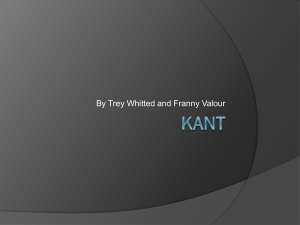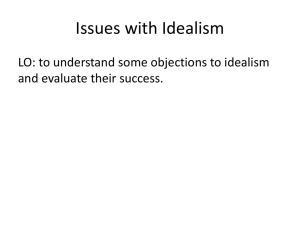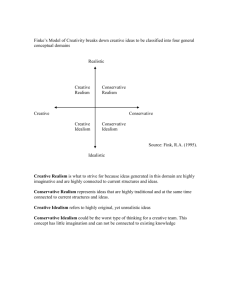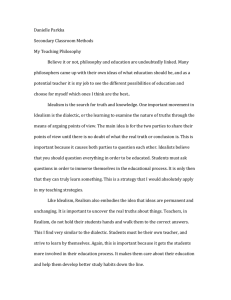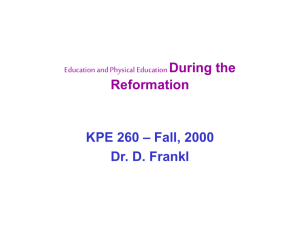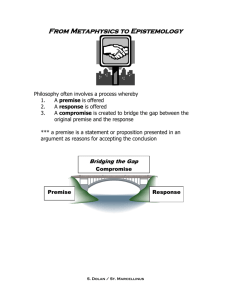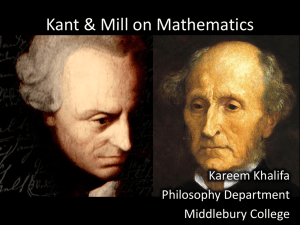24.201 Topics in History of Philosophy: KANT Kant’s Refutations of Idealism
advertisement
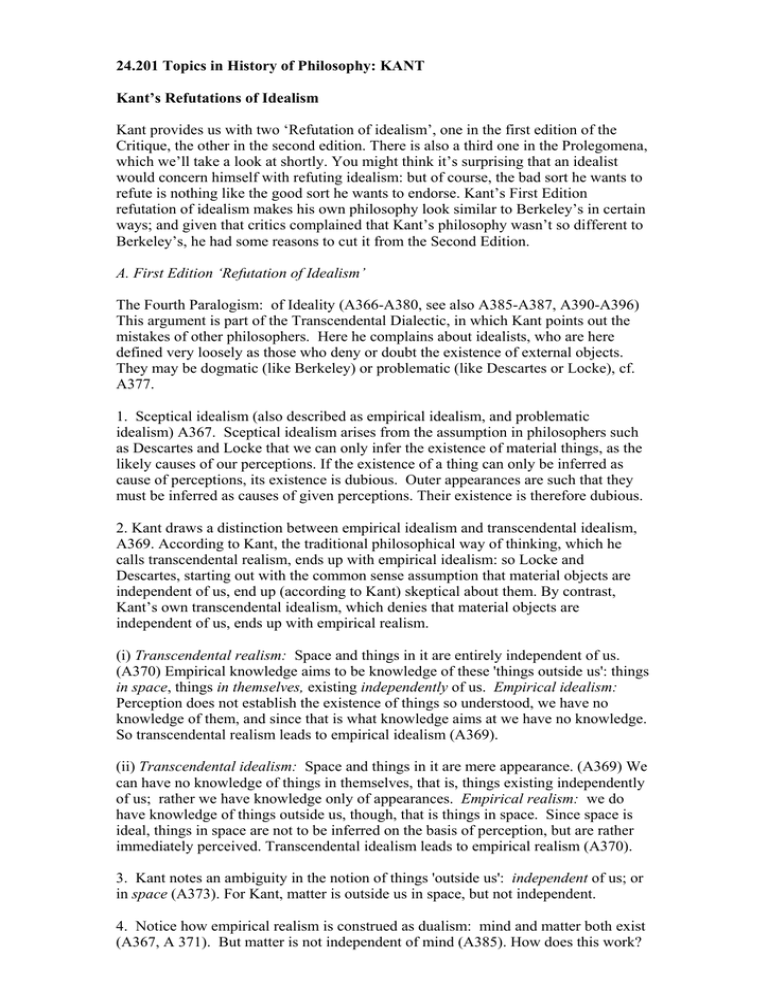
24.201 Topics in History of Philosophy: KANT Kant’s Refutations of Idealism Kant provides us with two ‘Refutation of idealism’, one in the first edition of the Critique, the other in the second edition. There is also a third one in the Prolegomena, which we’ll take a look at shortly. You might think it’s surprising that an idealist would concern himself with refuting idealism: but of course, the bad sort he wants to refute is nothing like the good sort he wants to endorse. Kant’s First Edition refutation of idealism makes his own philosophy look similar to Berkeley’s in certain ways; and given that critics complained that Kant’s philosophy wasn’t so different to Berkeley’s, he had some reasons to cut it from the Second Edition. A. First Edition ‘Refutation of Idealism’ The Fourth Paralogism: of Ideality (A366-A380, see also A385-A387, A390-A396) This argument is part of the Transcendental Dialectic, in which Kant points out the mistakes of other philosophers. Here he complains about idealists, who are here defined very loosely as those who deny or doubt the existence of external objects. They may be dogmatic (like Berkeley) or problematic (like Descartes or Locke), cf. A377. 1. Sceptical idealism (also described as empirical idealism, and problematic idealism) A367. Sceptical idealism arises from the assumption in philosophers such as Descartes and Locke that we can only infer the existence of material things, as the likely causes of our perceptions. If the existence of a thing can only be inferred as cause of perceptions, its existence is dubious. Outer appearances are such that they must be inferred as causes of given perceptions. Their existence is therefore dubious. 2. Kant draws a distinction between empirical idealism and transcendental idealism, A369. According to Kant, the traditional philosophical way of thinking, which he calls transcendental realism, ends up with empirical idealism: so Locke and Descartes, starting out with the common sense assumption that material objects are independent of us, end up (according to Kant) skeptical about them. By contrast, Kant’s own transcendental idealism, which denies that material objects are independent of us, ends up with empirical realism. (i) Transcendental realism: Space and things in it are entirely independent of us. (A370) Empirical knowledge aims to be knowledge of these 'things outside us': things in space, things in themselves, existing independently of us. Empirical idealism: Perception does not establish the existence of things so understood, we have no knowledge of them, and since that is what knowledge aims at we have no knowledge. So transcendental realism leads to empirical idealism (A369). (ii) Transcendental idealism: Space and things in it are mere appearance. (A369) We can have no knowledge of things in themselves, that is, things existing independently of us; rather we have knowledge only of appearances. Empirical realism: we do have knowledge of things outside us, though, that is things in space. Since space is ideal, things in space are not to be inferred on the basis of perception, but are rather immediately perceived. Transcendental idealism leads to empirical realism (A370). 3. Kant notes an ambiguity in the notion of things 'outside us': independent of us; or in space (A373). For Kant, matter is outside us in space, but not independent. 4. Notice how empirical realism is construed as dualism: mind and matter both exist (A367, A 371). But matter is not independent of mind (A385). How does this work? Kant assumes here that that immediacy of perception is the key to knowledge. This seems quite unlike the sophisticated talk of the Analytic, according to which objects are representations brought under rules. His idealism is expressed most extremely here, e.g. at A383: If I remove the thinking subject, the whole corporeal world must at once vanish. He even suggests there is something ‘deceptive’ about the way matter appears in space, hovering outside us (A385-6). 5. Does empirical dualism solve the problems of transcendental dualism (A391)? How can mind and matter interact? Kant here seems to suggest that matter is not an external cause, but a mere representation. What then is the cause of our representations? Kant’s answer: things in themselves, which we don’t know. So how do we know they are causes? Notice the hands off move: Kant’s opponent must prove that things in themselves cannot be the cause of our representations, which they can’t do of course. But is this the right way to think about the burden of proof? 6. The outcome of this ‘refutation’ of idealism: Kant’s idealism is pretty similar to Berkeley’s, but with the addition of unknown things in themselves. Who wins in this exchange? 7. Now take a look at the ‘refutation of idealism’ that appears in the Prolegomena. Idealism consists in the claim that there are none other than thinking beings; the other things which we believe we perceive in intuition are only representations in the thinking beings, to which in fact no object outside the latter corresponds. I say on the contrary: things are given to us as objects of our senses situated outside us, but of what they may be in themselves we know nothing; we only know their appearances, i.e. the representations that they effect in us when they affect our senses. Consequently I do indeed admit that there are bodies outside us, i.e. things which, although wholly unknown to us as to what they may be in themselves, we know through the representations which their influence on our sensibility provides for us, and to which we give the name of bodies. This word therefore merely means the appearance of that for us unknown but none the less real object. Can this be called idealism? It is the very opposite of it. That it can be said of many of the predicates of outer things, without detriment to their real existence, that they belong not to these things in themselves but only to their appearances and have no existence of their own outside our representations, is something that was generally accepted and admitted long before LOCKE’S time, but more so afterwards. To these predicates belong heat, colour, taste, etc. But that I for weighty reasons also count as mere appearances, in addition to these, the remaining qualities of bodies which are called primariae, extension, place, and space in general with all that depends on it (impenetrability or materiality, shape, etc.) is something against which not the slightest ground of inadmissibility can be adduced. A man who will not allow colours to be attached to the object in itself as qualities, but only to the sense of sight as modifications, cannot be called an idealist for that; equally little can my doctrine be called idealistic merely because I find that more of, indeed all, the qualities that make up the intuition of a body belong merely to its appearance; for the existence of the thing that appears is not thereby cancelled, as with real idealism, but it is only shown that we cannot know it at all through the senses as it is in itself.1 On the face of it, this argument matches up with that of the Fourth Paralogism. Kant is apparently bringing all qualities of material objects into the mind, not just colour and the other secondary qualities, but the primary qualities too. Whether this is the best way to read the argument is a question we’ll come back to in the next lecture. B. The Second Edition Refutation of Idealism (B274-B279). Consciousness of my own existence as temporal (‘determined in time’) proves the existence of permanent objects in space outside me To have an empirical consciousness of my own existence in time, I must have perceptions of a permanent—which is not the same as permanent perceptions (cf. p. 36). Objective experience requires that we make distinctions within the objective world between the different time relations different things have (successive events, persisting things, whose parts co-exist); and between the objective and subjective time orders, the latter always successive, the former having all three time relations. This argument is not very clear. Kant himself does not seem entirely satisfied with it, indeed he admitted certain ‘obscurity in the expressions’, and wrote an extensive footnote to the Preface to his Second Edition (Bxl, footnote a), attempting to clarify and amend it. What we can do for the present is note one well-known interpretation of the argument, offered by Strawson; and note some apparent thematic connections between this argument and other arguments of the First Critique. 1. Strawson’s version of the argument. I trace a subjective, experiential route through an objective world: so it is not simply, ‘now A, now B, now C’, but ‘Here now A, Here now B, Here now C’. Thinking about ‘here, now’ requires thinking about a contrast with a possible ‘somewhere else, now’ (at the same time, different place: this implies possible coexistence); and thinking about a possible contrast with ‘here, later on’ (same place, different time: this implies persistence, at least of the spatial framework). So empirical consciousness of my subjective experience requires me to think about a wider and enduring spatial framework. And (maybe) it requires that I am able to identify and reidentify particulars. (See Strawson, Bounds of Sense; this is also a theme of another book by Strawson, Individuals, though this latter is not a commentary on Kant.) 2. Brief comments on Kant’s notes. Note 1. Experience of self requires intuition, and intuition requires outer objects; is this because intuition is, in our case, passive. Note 2. Perception of time (e.g. temporal properties of our own inner experience) requires space, and requires a permanent in space: examples, the motion of the sun, and clocks. The idea seems to be that you can only tell time passing if you have something spatial and (relatively?) permanent to do it with. An odd argument, which may have connections with the First Analogy, see below. Note 3. How to distinguish dreams from reality: a Cartesian theme again, and Kant's answer is that coherence is the mark of reality. Compare this to the Transcendental Deduction, where the criterion of objectivity is that of rule governedness (A104). Possible relationship of the Second Edition Refutation of Idealism to— 1. —The Transcendental Aesthetic. Spatiality is the form of intuition for providing us with different particulars, therefore things distinct from ourselves (recall the ‘first metaphysical exposition’). We can have no conception of a self as different from 1Prolegomena, p.45. ed. Peter G. Lucas (Manchester: Manchester University Press, 1953) other things unless space is referred to, unless the self is a point of view on a spatial world of things distinct from the self. To think of things as distinct from us, we have to think of them as spatial. (But Kant’s idealist opponent could accept this and say, no need to think of things as distinct from us.) 2. —The Transcendental Deduction. A theme of the Transcendental Deduction is that there is, so to speak, no ‘I’ without an ‘it’, no self-consciousness without things, no consciousness without an object, no unifier without a unified. Is this a way of helping us understand what is going on in the Second Edition Refutation of Idealism? But note that the self of the Refutation of Idealism does not seem to be the same as the transcendental unity of apperception—it is rather the empirical self, determined in time, and knowledge of which requires intuition (B277). 3. —The First Analogy. In the First Analogy we are told that experience of the successive events of the subjective time order requires a contrast with the possibly different time relations of the objective time order. The objective time relations (succession, co-existence) presuppose persistence. This seems more promising, since (unlike with the Transcendental Deduction) we have here a focus on temporal aspects of self-consciousness; cf. also Kant’s clarificatory Preface Note (Bxl, footnote a.) 4. —The Third Analogy: all things that co-exist stand in relations of mutual interaction. How it is with any one thing depends on how it is with the others. If I am a thing, then how it is with me depends on how it is with other things interacting with me. Those other things must be in space (Aesthetic) and persistent (First Analogy). There is also a possible connection here with fact that our intuition is passive, receptive. As with the other arguments we have just mentioned, we have here an argument which affirms a dependence relation between distinct things, so it could conceivably be relevant to the Refutation of Idealism: however, the Third Analogy was supposed to apply to substances, and Kant says the empirical self is not a substance. Besides, the Third Analogy is no less difficult to understand than the Refutation of Idealism. 5. —The First Edition Refutation. There is some common ground between the two ‘Refutations of idealism’ in the Critique: first, the apparently Cartesian starting point, experience of the self and its conscious states; and second, the conclusion about the immediacy of our perception of something permanent. But there is also some apparent outright contradiction. In the Second Edition Refutation, the thing is explicitly not a mere representation, contrary to the First Edition. How to resolve this? One possibility is that in the Second Edition, Kant is talking about things in themselves. But this can’t be right: Kant is talking about the empirical self and the empirical world, both in time. Alternatively, we might interpret Kant to mean that we must have knowledge of something distinct from the empirical self, as per the ‘empirical dualism’ of his other argument—but not distinct from the transcendental self. Kant might be saying that the empirical self and empirical things are equally ideal, equally representations, but in order to have representations of the ‘empirical self’ kind, we need representations of ‘material object’ kind. And his claim in the second edition that this object is not a ‘representation’ – well, we would have to take that with a large pinch of salt.
